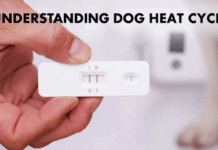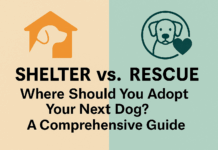Last Updated on April 8, 2024 by Dogs Vets
Dogs hold a special place in many people’s lives, and they act as loyal companions. They can bring joy, laughter, and unconditional love into their homes and enrich the entire family’s life as a whole. As a responsible pet owner, you must ensure that your furry friends receive the care and attention they deserve to thrive.
There are a lot of considerations when you want to adopt a canine. If you want to be an excellent fur parent, meeting the basic needs of your pets is a must.
Whether you’re already an expert or a novice parent, it’s still best to assess if they have the bedding, treats, water, and nutritious food available before you get them in the first place.
Learning all about it on the best platform, like Dog Wonders, can be a good idea, especially if you’re still thinking about it. For one, this is a website that discusses all about dogs, and you’ll learn about the symptoms of various diseases, such as sinusitis and roundworms.
Avoid obesity, sickness, and illnesses with their guides and unlock a quality of life that your dog will enjoy. You can check out more information below for a better guide.
Nutrition: The Foundation of Health and Vitality in Pets
Dogs are naturally carnivorous, but their intestinal tract and tooth structure have already adapted to a more omnivorous diet. Most canines have evolved, and their bodies are now using carbohydrates as a source of energy instead of relying on proteins and fats.
It’s best to feed them high-quality and premium food that you can afford based on their size, breed, age, and activity levels. Their primary needs include vitamins, minerals, carbohydrates, fats, water, and proteins, and you can speak to your veterinarian to know more about their dietary requirements.
As mentioned, there are websites like Dog Wonders that guide recommended feeding practices, including portion control, feeding schedules, and the avoidance of harmful foods such as chocolate, onions, raisins, and grapes, which can be toxic. Providing fresh and clean water that’s available at all times of the day can also replenish their needs, so make sure that it’s accessible.
Other must-haves for a healthier digestive tract can include green vegetables. As with plant-based diets, chlorophyll often detoxifies the body of your dog, and this is going to be an excellent food for good bacteria. Other owners notice that various breeds may eat grasses when they crave chlorophyll, so give this to them as needed.
Probiotics can also be good, and they can reinstate good bacteria in the digestive system. However, they should not be a part of the daily diet, but sprinkle them about twice a month, and it should be fine.
Sweet potatoes and canned pumpkins can also help with constipation and inflammation, but make sure to bake them first.
Exercise: Promoting Physical and Mental Well-Being

Regular exercise is essential for maintaining your canines’ physical and mental well-being, regardless of their age or breed.
Fortunately, there are sites that offer a variety of strategies for ensuring adequate physical activity, from playful games and brisk walks to more structured activities like agility training and swimming.
Getting into an exercise program can also be a good idea for first-time owners who don’t have any idea about what to do, and there are trainers who can accommodate their needs.
Puppies often benefit from supervised play sessions that encourage socialization and promote healthy growth and development.
Adults require daily exercise to maintain cardiovascular health, muscle tone, and mental stimulation, while the older ones may have different exercise needs, requiring gentle activities that support mobility and joint health while avoiding overexertion.
You can also try to read blogs and watch helpful content about what exactly you should do to prevent injuries and accidents.
Brain games can be a great idea where you can place treats under some of the lighter furniture that your pet can flip over. Keeping them in a structured and consistent routine is a must. They prevent health-related issues like diabetes or obesity when they are always engaging in brisk walks, jogging, and interesting play sessions.
Also, there are a lot of social opportunities outside to take advantage of. In a park, your canine can see others, and this helps them prevent anxiety, especially if they are always exposed to new environments.
You can also bond with other owners, where the pets can share various activities and moments that can help them grow. This can result in a sense of trust and companionship that will be great for their overall well-being, and this is going to prevent your canine from biting your guests and family members when they decide to visit.
Grooming: Maintaining Hygiene and Comfort

Prevent infections with regular sessions of grooming and by inspecting abnormalities and signs of infection. Trimming the dog’s nails and brushing their teeth can prevent the buildup of bacteria. Remove allergens and debris as well to reduce the chances of them getting sick and having a tough time. Any signs of itchiness should also be checked as early as possible.
Regular brushing helps remove loose fur, prevent mats, and distribute natural oils for a shiny, healthy coat. Depending on your dog’s breed and coat type, grooming requirements may vary, with some requiring daily brushing while others may only need occasional grooming sessions.
Trimming the nails is essential to prevent overgrowth, which can lead to discomfort and potential injury. Also, regular ear cleaning and dental care are essential components of a complete grooming routine, helping to prevent infections and maintain oral health.
You can also avoid unpleasant odors in the process and make sure that your canine smells fresh. Living in a hygienic environment can help them thrive and stay happier.
Health and Wellness Resources: Preventive Care and Emergency Preparedness
Knowing the common issues with canines can help you recognize symptoms and seek timely veterinary care when needed.
From allergies and skin infections to gastrointestinal issues and joint problems, understanding potential health concerns allows you to take proactive steps to safeguard your dog’s well-being. See information about parasites on this site here.
It’s also essential to read blog posts about preventative care measures, such as vaccinations, parasite control, and regular veterinary check-ups. These proactive measures help protect your dog from infectious diseases, parasites, and other preventable health problems.
With these resources, you can be better equipped with essential emergency first aid tips for common situations, such as choking, wounds, and heatstroke. Arming yourself with knowledge and resources to respond effectively in emergencies can provide lifesaving care for your dog until professional help is available.
Different Dog Breeds: Understanding Unique Characteristics and Care Needs
These sites let you know more about the diversity of dog breeds and offer valuable insights into their specific traits and requirements.
Whether you’re drawn to the intelligence of a Border Collie, the loyalty of a Labrador Retriever, or the elegance of a Greyhound, understanding breed-specific traits is essential for providing appropriate care and training.
Different breeds have varying exercise requirements, grooming needs, and predispositions to certain health issues, and by researching your chosen breed and consulting resources like Dog Wonders, you can ensure that you’re well-prepared to meet your new pet’s needs and provide them with a loving and supportive home.
Understanding Behaviors and Communication Signals
One way to maintain a harmonious relationship with your canine companions is the ability to comprehend their unique language of gestures, vocalizations, and body language.
Fortunately, some experts are very interested in their behaviors, offering insights into the meaning behind the various signals and cues dogs use to communicate with humans and other animals.
From the wag of a tail to the position of their ears, understanding these subtle cues allows owners to interpret their pet’s emotions, intentions, and needs more accurately. With the right platform, you can deepen your understanding of your pet, forge stronger bonds, and navigate interactions with confidence and empathy.
Addressing Excessive Barking and Chewing
While dogs bring boundless joy and companionship into their owners’ lives, they may also exhibit certain behaviors that pose challenges for their owners.
You’ll need the best professionals who can provide practical solutions for addressing common behavioral problems such as destructive chewing and separation anxiety.
Through a combination of positive reinforcement techniques, environmental management strategies, and behavior modification exercises, owners can effectively address these issues and promote more desirable behaviors in their pets. Understanding your canine better can lead to improved well-being and help them enjoy life here on earth.
Positive Reinforcement Techniques to Know

At the heart of effective dog training lies the principle of positive reinforcement, which involves rewarding desired behaviors to encourage their repetition. Dog Wonders champions the use of positive reinforcement techniques as a humane and effective way to shape desired behaviors in dogs.
When you’re able to reward behaviors, such as sitting, staying, and coming when called with treats, praise, or toys, dog owners can reinforce these actions and strengthen the bond between themselves and their pets.
Also, Dog Wonders guides use clicker training, shaping, and capturing techniques to teach new behaviors and modify existing ones.
Through patience, consistency, and the judicious use of positive reinforcement, dog owners can help their pets become well-behaved, obedient, and happy members of the family. If your dog has a problem, it’s best to take it to the vet as soon as possible.
What to Know About Selecting a New Vet
Your pet’s doctor is going to give you scientific-based and valuable advice about what’s good for your dog. You also need them, especially if you’ve moved into a new neighborhood or you’re not satisfied with the services of your current vet.
Some of the things that can help you look for the more effective ones include the following:
Asking about the Different Kinds of Services they Provide
Larger clinics may have ultrasounds, which is ideal if you’re expecting a pregnant pet shortly. However, a non-negotiable should include blood tests and enough staff to handle many patients every single day. This way, their services will be faster, and they can answer any questions that you may have.
Check their credentials and make sure that they have a DVM degree. They should also be certified and licensed to operate in your area whenever possible.
You can also ask for referrals whenever possible because you often never know when you’re going to see them. More about DVM in this link: https://learn.org/articles/What_is_a_DVM_Degree.html.
Learn More about Conditions that they Can Treat
Stomach upsets, skin conditions, and infections are just some of the more common reasons why pet owners are triggered to visit a veterinary clinic. Pet parents are often considered to have dermatitis, alopecia, stings, bites, dandruff, mange, impetigo, hot spots, and yeast infections.
There are also cases of accidental poisoning, parasitic infection, mites, and allergies that many owners are concerned about, and this is why you need someone knowledgeable and competent at their jobs, for better outcomes.
Fact Check
We strive to provide the latest valuable information for pet lovers with accuracy and fairness. If you would like to add to this post or advertise with us, don’t hesitate to reach us. If you see something that doesn’t look right, contact us!

















